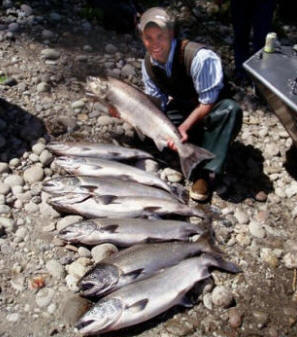forum
library
tutorial
contact

Big Run of Fall Chinook has Started
by Rob PhillipsYakima Herald, September 3, 2013
|
the film forum library tutorial contact |

|
Big Run of Fall Chinook has Startedby Rob PhillipsYakima Herald, September 3, 2013 |
 Holy smokes! Have you checked the fish counts at Bonneville Dam lately? The fish counters are going to have to throw some cold water on their calculators, because there have been some absolutely huge counts of fall chinook salmon climbing through the fish ladders.
Holy smokes! Have you checked the fish counts at Bonneville Dam lately? The fish counters are going to have to throw some cold water on their calculators, because there have been some absolutely huge counts of fall chinook salmon climbing through the fish ladders.
In a three-day stretch last week, nearly 85,000 fall chinook moved up over Bonneville, with almost 34,000 of those coming up river on Friday. Add to that total some 2,000 steelhead and another 1,000 coho and it tells you there is a bunch of fish headed our way up the Columbia.
An estimated 432,500 adult upriver bright chinook are expected to return to their spawning grounds upstream of Bonneville Dam. If that pans out, it would break the record of 420,700 set in 1987 -- and more than 375,000 fall chinook are over Bonneville already.
Some of those fish will go up the Klickitat River, others will come up the Yakima, and some will continue on up the Snake River.
But the bulk of those fish, specifically the fall chinook -- also known as upriver brights -- are headed to the Hanford Reach portion of the Columbia River. The region's biggest run of naturally spawning salmon start arriving in late August and show up in full force in the next three or four weeks.
At all of these places anglers get a crack at the largest of all the salmon.
While most of the fish arrive in the Hanford Reach and the waters below Priest Rapids Dam in late September and early October, some of the fish begin showing up as early at the first of September. And while the fishing may not be as good as it will be later, it's not uncommon for anglers to catch one or two over a day of fishing.
The most popular holes are located above the Tri-Cities, but in recent years anglers have discovered a few other spots worth trying. Right now anglers are catching fish at the mouth of the Klickitat or at the mouth of the Deschutes, and in the last couple of years a decent fishery has developed at the mouth of the Yakima River near Richland.
Anglers will also fish the area of the Columbia known as White Bluffs. Either by boating up from Richland, or taking a rough road into a single boat launch where the old ferry used to cross the river at White Bluffs, anglers will troll in the deeper holding holes in that part of the Columbia.
Later in September, as the fish continue to move upstream, anglers start concentrating on one of the most popular holes called the "Hog Hole," a deep slot that runs for a couple of hundred yards right down the middle of the river just above the Vernita Bridge. I have caught fish in the Hog Hole as early as Sept. 6.
Anglers can use several techniques to catch the fall chinook. One of the old standbys is to run a herring off of a downrigger. Some anglers will just run the bait alone, without any attraction, while others will use a rotating flasher or an in-line attractor such as a Fish Flash.
Another technique that has worked well in the deeper holes is to back troll a T-4 or M-2 FlatFish with a herring wrap. A dropper weight or a downrigger is used to get the lures down to where the fish are holding, and then it is slowly backtrolled through the soft edges of the hole.
Maglips will also work, either fished alone or with a herring or sardine wrap. And the good thing about using these lures, if you are fishing water no deeper than 18 to 20 feet, you don't need to use a dropper weight.
Other lures that will work include deep-diving plugs like the Magnum FatFish, or the old style Magnum Wiggle Wart. Some anglers will use big bladed spinners with good results.
In the past few years a Super Bait, packed with tuna and run behind a rotating flasher, has been another popular rigging for the big fish.
It seems on different days, different lures and techniques will work, so be prepared to try several different riggings until you find what the fish want.
It is recommended anglers keep an eye on the depth finder in any of these locations because the depths are constantly changing. Keeping your lure or bait a few feet off of the bottom is normally where you want it to be, so watch the depths and adjust accordingly.
Water flows at the dams can change the water levels drastically, especially on the weekends, so you have to really watch the water. In a matter of minutes it can go from normal to up in the trees. And when they raise the river it can really kill the bite.
A possible record run of upriver brights is headed our way right this minute. They are blasting over the dams by the tens of thousands. And whether it ends up being a record run or not, it should be a fantastic year for fall chinook fishing.
learn more on topics covered in the film
see the video
read the script
learn the songs
discussion forum
